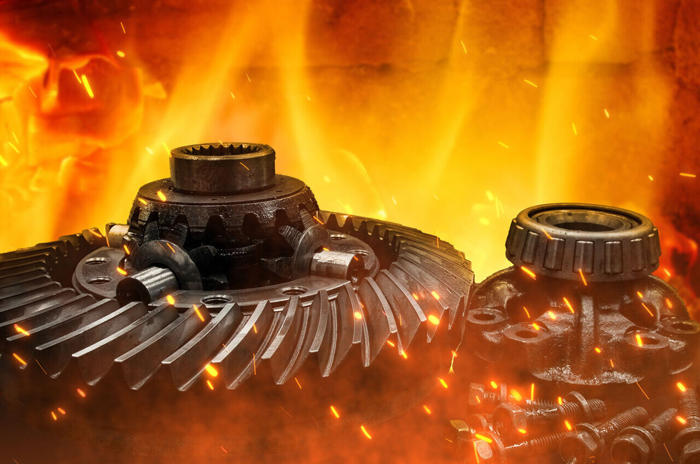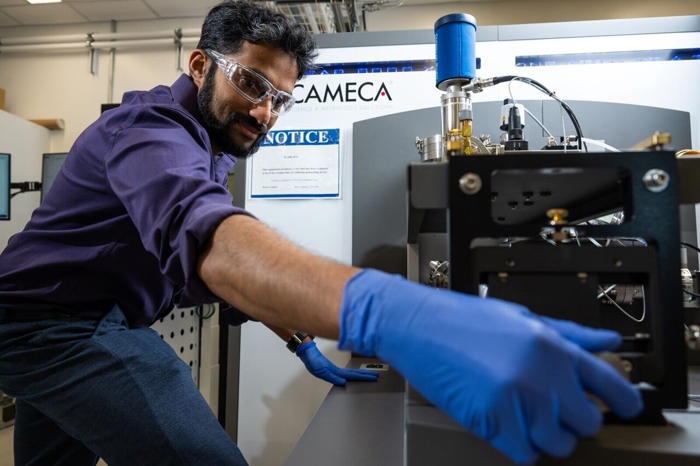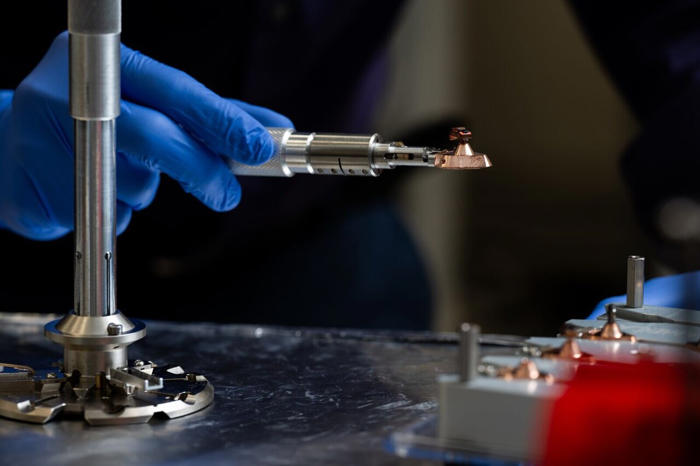Team develops predictive tool for designing complex metal alloys that can withstand extreme environments

Researchers have developed a tool to predict how new high-entropy alloys will behave under high-temperature oxidative environments. Development of new alloys is important for the aerospace and nuclear power industries. Credit: Nathan Johnson | Pacific Northwest National Laboratory
Cooks love stainless steel for its durability, rust resistance and even cooking when heated. But few know the secret that makes stainless steel so popular. It's the metal chromium in stainless steel, which reacts with oxygen in the air to form a stable and protective thin coating for protecting the steel underneath.
These days, scientists and engineers are working to design alloys that can resist extreme environments for applications such as nuclear fusion reactors, hypersonic flights and high-temperature jet engines. For such extreme applications, scientists are experimenting with complex combinations of many metals mixed in equal proportions in what are called multi-principal element alloys or medium- to high-entropy alloys. These alloys aim to achieve design goals such as strength, toughness, resistance to corrosion and so on.

Materials scientist Arun Devaraj works at an atom probe tomography instrument at Pacific Northwest National Laboratory. This precision instrument can show the placement of atoms in tiny samples of materials, such as metal alloys. Credit: Andrea Starr | Pacific Northwest National Laboratory
Specifically, researchers seek alloys resistant to corrosion that can happen when metals react with oxygen in the atmosphere, a process called oxidation. These alloys are typically tested in a "cook-and-look" procedure where alloy materials are exposed to high-temperature oxidation environments to see how they respond.
But now, a multidisciplinary research team led by scientists at the Department of Energy's Pacific Northwest National Laboratory and North Carolina State University combined atomic-scale experiments with theory to create a tool to predict how such high-entropy alloys will behave under high-temperature oxidative environments. The research, published in the journal Nature Communications, offers a road map toward rapid design and testing cycles for oxidation-resistant complex metal alloys.

Microscopic samples of complex metal alloy are placed on a sampling vessel to enter the atom probe tomography instrument. Credit: Andrea Starr | Pacific Northwest National Laboratory
"We are working toward developing an atomic-scale model for material degradation of these complex alloys, which then can be applied to design next-generation alloys with superior resistance to extreme environments for a wide variety of applications such as the aerospace and nuclear power industries," said Arun Devaraj, co-principal investigator of the study and a PNNL materials scientist specializing in understanding metal degradation in extreme environments.
"The goal here is to find ways to rapidly identify medium- to high-entropy alloys with the desired properties and oxidation resistance for your chosen application."
A complex alloy recipe
For their recent experiments, the research team studied the degradation of a high-entropy alloy with equal amounts of the metals cobalt, chromium, iron, nickel and manganese (CoCrFeNiMn, also called the Cantor alloy). The research team examined oxide formed on the Cantor alloy using a variety of advanced atomic-scale methods to understand how each element arranges itself in the alloy and the oxide.
They discovered that chromium and manganese tend to migrate quickly toward the surface and form stable chromium and manganese oxides. Subsequently, iron and cobalt diffuse through these oxides to form additional layers.
By adding a small amount of aluminum, they discovered that aluminum oxide can act as a barrier for other elements migrating to form the oxide, thereby reducing the overall oxidation of the aluminum-containing Cantor alloy and increasing its resistance to degradation at high temperatures.
"This work sheds light on the mechanisms of oxidation in complex alloys at the atomic scale," said Bharat Gwalani, co-corresponding author of the study. Gwalani began the study while a scientist at PNNL and continued the research in his current role as an assistant professor of materials science and engineering at North Carolina State University. He added, "by understanding the fundamental mechanisms involved, this work gives us a deeper understanding of oxidation across all complex alloys."
Predictive models
"Right now there are no universally applicable governing models to extrapolate how a given complex, multi-principal element alloy will oxidize and degrade over time in a high-temperature oxidation environment," said Devaraj. "This is a substantial step in that direction."
The team's careful analysis revealed some universal rules that can predict how the oxidation process will proceed in these complex alloys. Computational colleagues from NCSU developed a model called the Preferential Interactivity Parameter for early prediction of oxidation behavior in complex metal alloys.
Ultimately, the research team expects to expand this research to develop complex alloys with exceptional high-temperature properties, and to do so very quickly by rapid sampling and analysis. The ultimate goal is to choose a combination of elements that favor the formation of an adherent oxide, said Devaraj. "You know oxide formation will happen, but you want to have a very stable oxide that will be protective, that would not change over time, and would withstand extreme heat inside a rocket engine or nuclear reactors."
A next step will be to introduce automated experimentation and integrate additive manufacturing methods, along with advanced artificial intelligence, to rapidly evaluate promising new alloys. That project is now getting underway at PNNL as a part of the Adaptive Tunability for Synthesis and Control via the Autonomous Learning on Edge (AT SCALE) Initiative.
"That kind of discovery loop for materials discovery will be very relevant for further expanding our knowledge of these novel alloys," said Devaraj, who also has a joint faculty appointment at the Colorado School of Mines.
In addition to Gwalani and Devaraj, PNNL scientists Sten Lambeets, Matthew Olszta, Anil Krishna Battu and Thevuthasan Suntharampillai contributed; as well as Martin Thuo, Aram Amassian, Andrew Martin, Aniruddha Malakar, and Boyu Guo of NCSU; Elizabeth Kautz, an assistant professor of nuclear engineering at North Carolina State, who also has a joint appointment with PNNL; Feipeng Yang and Jinghua Guo of Lawrence Berkeley National Laboratory; and Ruipeng Li of Brookhaven National Laboratory.
To investigate the arrangement of atoms within the samples, the research team used in situ atom probe tomography at PNNL. These results were correlated with electron microscopy and synchrotron-based grazing incidence wide-angle X-ray scattering at the National Synchrotron Light Source II, BNL, and X-ray absorption measurements conducted at the Advanced Light Source, LBNL.
More information: Bharat Gwalani et al, Mechanistic understanding of speciated oxide growth in high entropy alloys, Nature Communications (2024). DOI: 10.1038/s41467-024-49243-8
Provided by Pacific Northwest National Laboratory
This story was originally published on Phys.org. Subscribe to our newsletter for the latest sci-tech news updates.
